What Produces The Most Atp
5.9: Cellular Respiration
- Folio ID
- 17025
This inviting campfire can be used for both heat and light. Oestrus and light are two forms of energy that are released when a fuel like woods is burned. The cells of living things also get energy past "burning." They "burn" glucose in the process called cellular respiration.
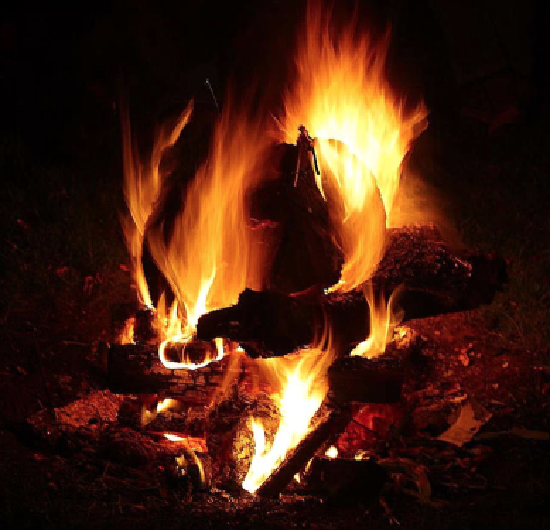
Inside every cell of all living things, energy is needed to carry out life processes. Energy is required to intermission downwards and build upwardly molecules and to send many molecules across plasma membranes. All of life's work needs energy. A lot of free energy is besides only lost to the surround as rut. The story of life is a story of energy menstruum — its capture, its change of form, its use for work, and its loss as heat. Energy, unlike affair, cannot be recycled, so organisms require a constant input of energy. Life runs on chemical free energy. Where do living organisms become this chemic energy?
Where do organisms get energy from?
The chemical energy that organisms need comes from food. Food consists of organic molecules that store energy in their chemic bonds. Glucose is a simple saccharide with the chemical formula \(\mathrm{C_6H_{12}O_6}\). Information technology stores chemical energy in a concentrated, stable grade. In your body, glucose is the form of energy that is carried in your blood and taken up by each of your trillions of cells. Cells practise cellular respiration to extract energy from the bonds of glucose and other food molecules. Cells can store the extracted energy in the form of ATP (adenosine triphosphate).
What is ATP?
Permit's have a closer look at a molecule of ATP, shown in the figure \(\PageIndex{2}\). Although information technology carries less energy than glucose, its structure is more complex. "A" in ATP refers to the majority of the molecule – adenosine – a combination of a nitrogenous base of operations and a five-carbon saccharide. "T" and "P" indicate the three phosphates, linked past bonds that hold the energy really used by cells. Usually, but the outermost bond breaks to release or spend energy for cellular piece of work.
An ATP molecule is similar a rechargeable battery: its energy can exist used by the prison cell when information technology breaks autonomously into ADP (adenosine diphosphate) and phosphate, and and then the "worn-out bombardment" ADP can be recharged using new energy to attach a new phosphate and rebuild ATP. The materials are recyclable, but retrieve that free energy is not! ADP can be farther reduced to AMP (adenosine monophosphate and phosphate, releasing additional energy. As with ADT "recharged" to ATP, AMP can be recharged to ADP.
How much energy does it cost to practice your body'due south work? A single cell uses well-nigh 10 1000000 ATP molecules per second and recycles all of its ATP molecules about every 20-30 seconds.
What Is Cellular Respiration?
Some organisms can brand their own food, whereas others cannot. An autotroph is an organism that can produce its own food. The Greek roots of the word autotroph mean "cocky" (motorcar) "feeder" (troph). Plants are the all-time-known autotrophs, but others be, including certain types of bacteria and algae. Oceanic algae contribute enormous quantities of food and oxygen to global food bondage. Plants are also photoautotrophs, a type of autotroph that uses sunlight and carbon from carbon dioxide to synthesize chemic energy in the class of carbohydrates. Heterotrophs are organisms incapable of photosynthesis that must therefore obtain energy and carbon from food by consuming other organisms. The Greek roots of the word heterotroph mean "other" (hetero) "feeder" (troph), meaning that their nutrient comes from other organisms. Even if the food organism is another animal, this nutrient traces its origins back to autotrophs and the process of photosynthesis. Humans are heterotrophs, equally are all animals. Heterotrophs depend on autotrophs, either straight or indirectly.
Cellular respiration is the procedure by which individual cells break down food molecules, such as glucose and release energy. The process is similar to burning, although it doesn't produce light or intense oestrus as a bivouac does. This is considering cellular respiration releases the energy in glucose slowly, in many small steps. It uses the energy that is released to form molecules of ATP, the energy-carrying molecules that cells use to power biochemical processes. Cellular respiration involves many chemical reactions, just they tin all be summed upward with this chemical equation:
\[\ce{C6H12O6 + 6O2 -> 6CO2 + 6H2O + Energy} \nonumber\]
where the energy that is released is in chemical free energy in ATP (vs. thermal energy every bit oestrus). The equation above shows that glucose (\(\ce{C6H12O6}\)) and oxygen (\(\ce{O_2}\)) react to form carbon dioxide (\(\ce{CO_2}\)) and water \(\ce{H_2O}\), releasing free energy in the procedure. Because oxygen is required for cellular respiration, it is an aerobic process.
Cellular respiration occurs in the cells of all living things, both autotrophs and heterotrophs. All of them catabolize glucose to form ATP. The reactions of cellular respiration can be grouped into three main stages and an intermediate stage: glycolysis, Transformation of pyruvate, the Krebs bike (too chosen the citric acid cycle), and Oxidative Phosphorylation. Figure \(\PageIndex{3}\) gives an overview of these iii stages, which are also described in particular below.
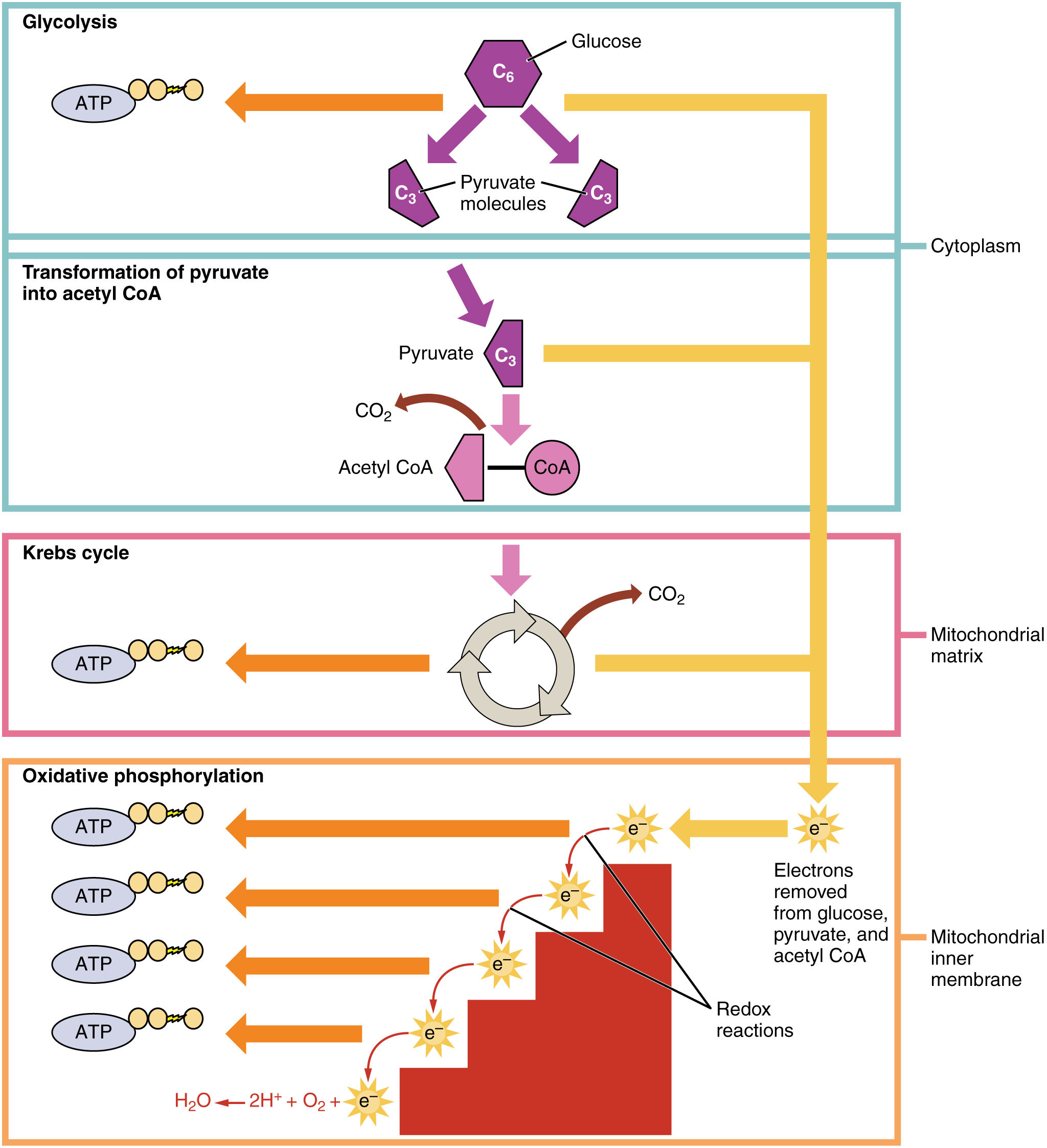
Glycolysis
The first stage of cellular respiration is glycolysis. This process is shown in the top box in Figure \(\PageIndex{3}\) showing a 6-carbon molecule beingness broken down into two three-carbon pyruvate molecules. ATP is produced in this procedure which takes place in the cytosol of the cytoplasm.
Splitting Glucose
The word glycolysis means "glucose splitting," which is exactly what happens in this stage. Enzymes split a molecule of glucose into two molecules of pyruvate (also known as pyruvic acid). This occurs in several steps, every bit shown in effigy \(\PageIndex{4}\). Glucose is first split into glyceraldehyde 3-phosphate (a molecule containing 3 carbons and a phosphate group). This process uses two ATP. Next, each glyceraldehyde three-phosphate is converted into pyruvate (a iii-carbon molecule). this produces two 4 ATP and ii NADH.
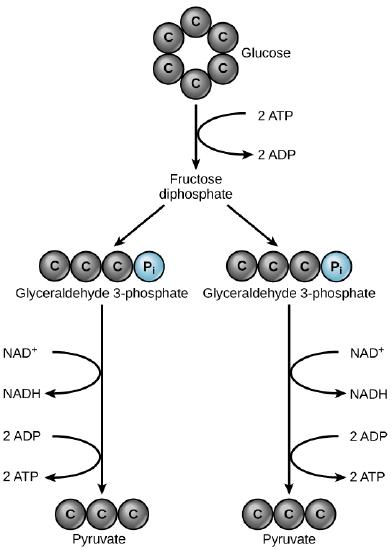
Results of Glycolysis
Energy is needed at the kickoff of glycolysis to split the glucose molecule into 2 pyruvate molecules. These two molecules go on to stage 2 of cellular respiration. The free energy to separate glucose is provided past two molecules of ATP. As glycolysis gain, energy is released, and the free energy is used to make four molecules of ATP. Equally a issue, at that place is a cyberspace proceeds of 2 ATP molecules during glycolysis. high-energy electrons are as well transferred to free energy-conveying molecules called electron carriers through the process
known as reduction. The electron carrier of glycolysis is NAD+(nicotinamide adenine diphosphate). Electrons are transferred to two NAD+ to produce two molecules of NADH. The energy stored in NADH is used in stage III of cellular respiration to make more ATP. At the end of glycolysis, the following has been produced:
• 2 molecules of NADH
• 2 net molecules of ATP
Transformation of Pyruvate into Acetyl-CoA
In eukaryotic cells, the pyruvate molecules produced at the stop of glycolysis are transported into mitochondria, which are sites of cellular respiration. If oxygen is available, aerobic respiration volition get forward. In mitochondria, pyruvate will be transformed into a ii-carbon acetyl group (by removing a molecule of carbon dioxide) that will be picked up past a carrier chemical compound called coenzyme A (CoA), which is made from vitamin B5. The resulting compound is called acetyl CoA and its production is oftentimes called the oxidation or the Transformation of Pyruvate (come across Figure \(\PageIndex{5}\). Acetyl CoA tin can be used in a variety of ways by the cell, simply its major function is to evangelize the acetyl group derived from pyruvate to the next pathway step, the Citric Acid Cycle.
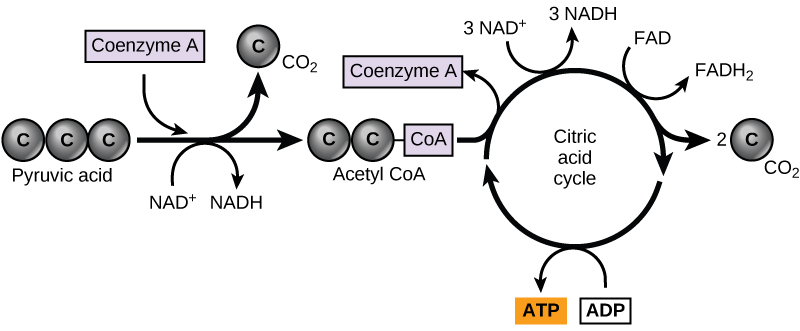
Citric Acid Cycle
Before you read about the last ii stages of cellular respiration, you need to review the structure of the mitochondrion, where these two stages take place. Equally y'all can run into from Figure \(\PageIndex{6}\), a mitochondrion has an inner and outer membrane. The space betwixt the inner and outer membrane is called the intermembrane infinite. The space enclosed by the inner membrane is called the matrix. The second stage of cellular respiration, the Krebs cycle, takes place in the matrix. The third stage, electron ship, takes place on the inner membrane.
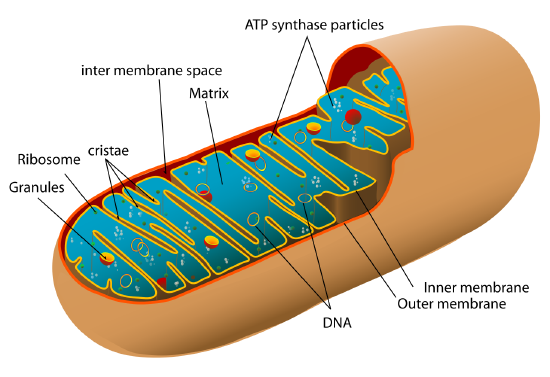
Think that glycolysis produces two molecules of pyruvate (pyruvic acid). Pyruvate, which has three carbon atoms, is split apart and combined with CoA, which stands for coenzyme A. The product of this reaction is acetyl-CoA. These molecules enter the matrix of a mitochondrion, where they start the Citric Acrid Cycle. The third carbon from pyruvate combines with oxygen to grade carbon dioxide, which is released every bit a waste product product. Loftier-energy electrons are also released and captured in NADH. The reactions that occur adjacent are shown in Effigy \(\PageIndex{7}\).
Steps of the Citric Acrid (Krebs) Cycle
The Citric Acid Wheel begins when acetyl-CoA combines with a four-carbon molecule called OAA (oxaloacetate; encounter the lower panel of Effigy \(\PageIndex{vii}\)). This produces citric acid, which has half-dozen carbon atoms. This is why the Krebs wheel is also chosen the citric acrid wheel. After citric acid forms, information technology goes through a serial of reactions that release energy. This energy is captured in molecules of ATP and electron carriers. The Krebs cycle has two types of energy-carrying electron carriers: NAD+ and FAD. The transfer of electrons to FAD during the Kreb'southward Bicycle produces a molecule of FADH2. Carbon dioxide is besides released as a waste product of these reactions. The final pace of the Krebs cycle regenerates OAA, the molecule that began the Krebs bike. This molecule is needed for the next plow through the cycle. Two turns are needed because glycolysis produces ii pyruvate molecules when it splits glucose.
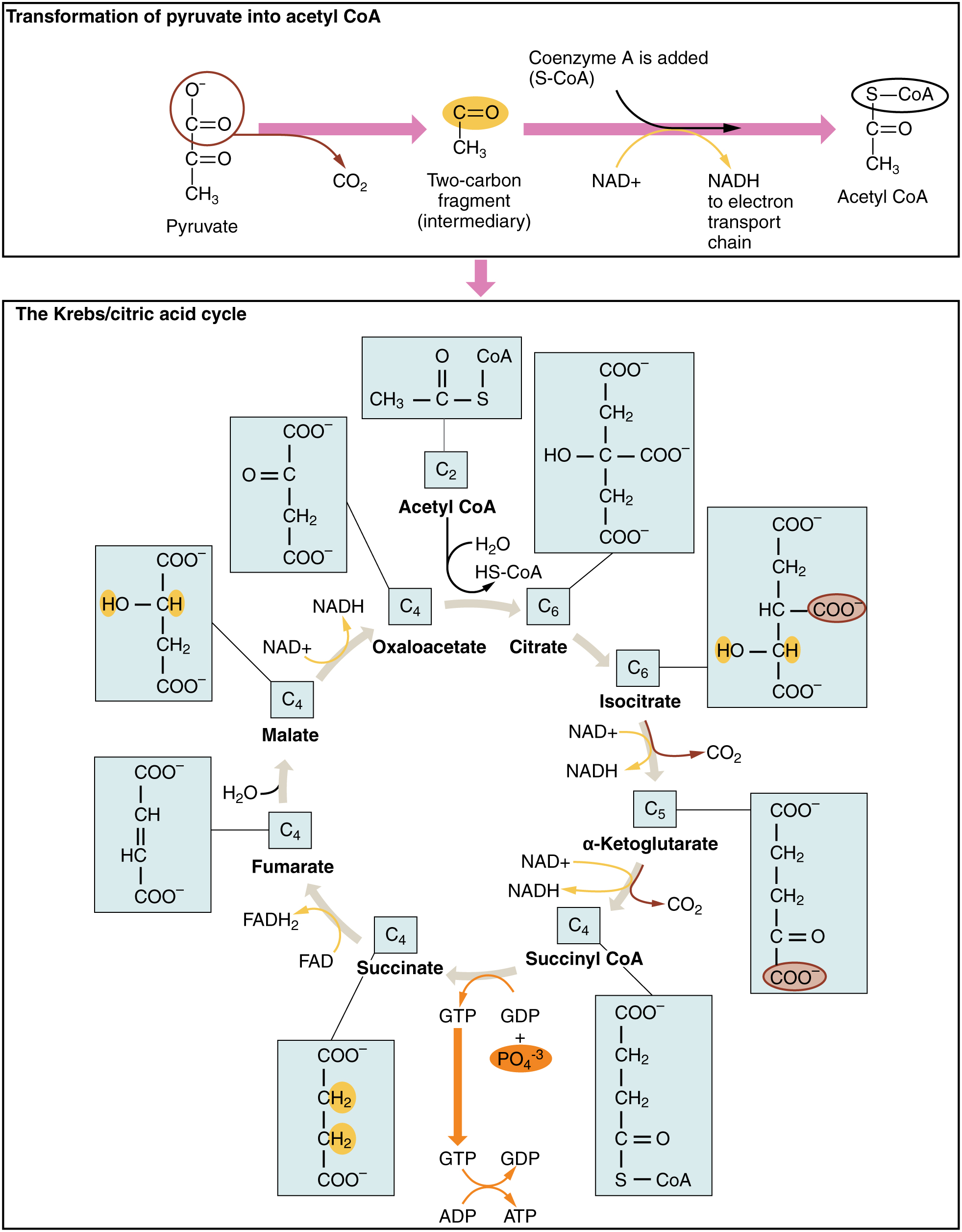
Results of the Citric Acrid Cycle
After the second plow through the Citric Acid Cycle, the original glucose molecule has been broken down completely. All six of its carbon atoms have combined with oxygen to form carbon dioxide. The energy from its chemical bonds has been stored in a full of 16 free energy-carrier molecules. These molecules are:
- two ATP
- eight NADH
- 2 FADH\(_2\)
- 6 CO\(_2\): 2 CO\(_2\) from Transformation of Acetyl CoA and 4 CO\(_2\) from Citric Acid Cycle.
Oxidative phosphorylation
Oxidative phosphorylation is the final phase of aerobic cellular respiration. At that place are two substages of oxidative phosphorylation, Electron send chain and Chemiosmosis. In these stages, energy from NADH and FADHii, which event from the previous stages of cellular respiration, is used to create ATP.
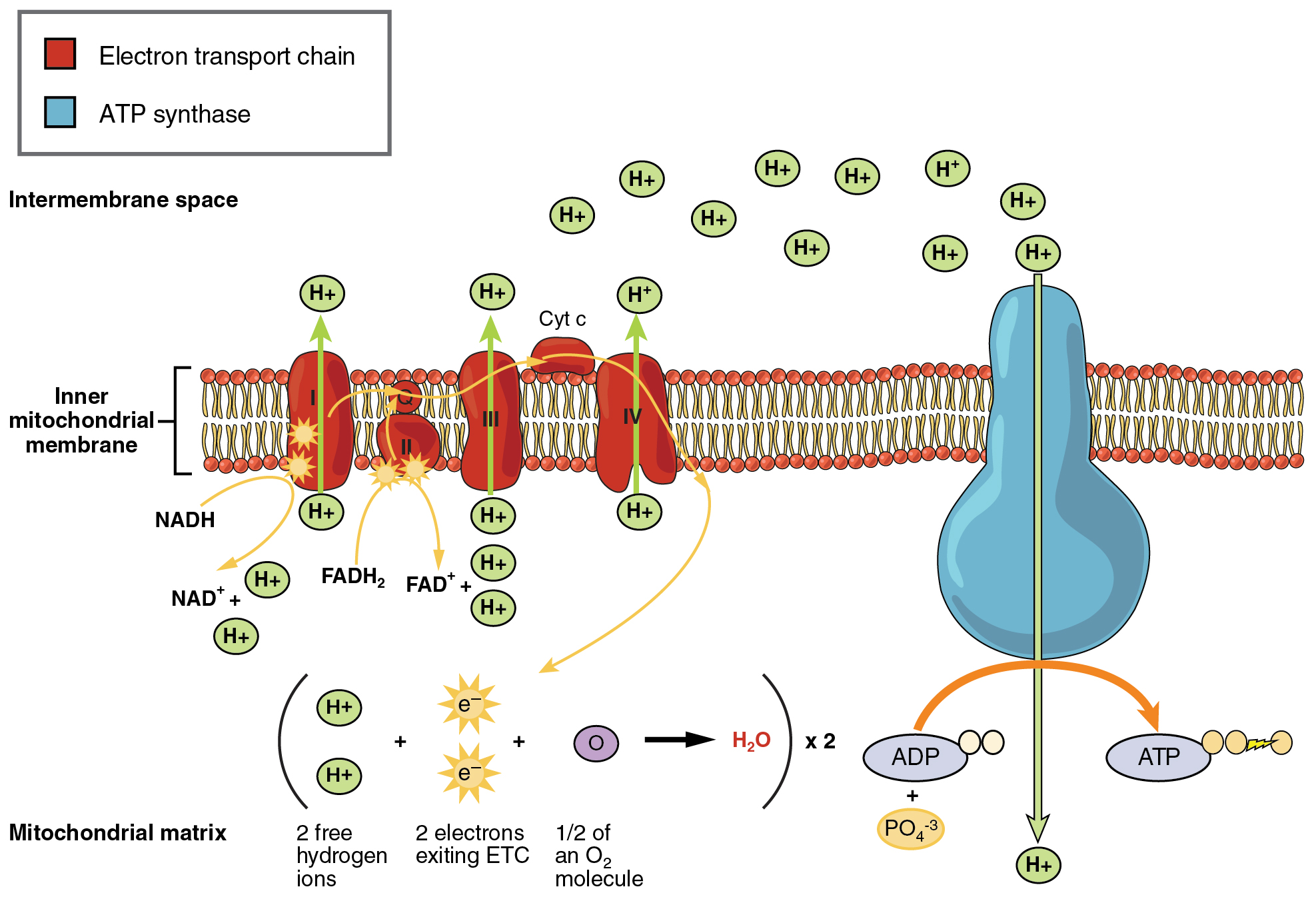
Electron Send Chain (ETC)
During this stage, high-energy electrons are released from NADH and FADHii, and they move along electron-transport chains plant in the inner membrane of the mitochondrion. An electron-transport chain is a serial of molecules that transfer electrons from molecule to molecule past chemical reactions. These molecules are found making upwardly the 3 complexes of the electron ship chain (red structures in the inner membrane in Figure \(\PageIndex{viii}\)). Every bit electrons flow through these molecules, some of the energy from the electrons is used to pump hydrogen ions (H+) beyond the inner membrane, from the matrix into the intermembrane space. This ion transfer creates an electrochemical gradient that drives the synthesis of ATP. The electrons from the final poly peptide of the ETC are gained by the oxygen molecule, and information technology is reduced to h2o in the matrix of the mitochondrion.
Chemiosmosis
The pumping of hydrogen ions across the inner membrane creates a greater concentration of these ions in the intermembrane space than in the matrix – producing an electrochemical gradient. This gradient causes the ions to menstruation dorsum beyond the membrane into the matrix, where their concentration is lower. The menses of these ions occurs through a protein complex, known as the ATP synthase circuitous (see bluish structure in the inner membrane in Figure \(\PageIndex{viii}\). The ATP synthase acts every bit a channel protein, helping the hydrogen ions across the membrane. The flow of protons through ATP synthase is considered chemiosmosis. ATP synthase also acts equally an enzyme, forming ATP from ADP and inorganic phosphate. It is the catamenia of hydrogen ions through ATP synthase that gives the energy for ATP synthesis. Afterward passing through the electron-send chain, the low-energy electrons combine with oxygen to form water.
How Much ATP?
You have seen how the three stages of aerobic respiration use the energy in glucose to make ATP. How much ATP is produced in all three stages combined? Glycolysis produces 2 ATP molecules, and the Krebs cycle produces two more. Electron transport from the molecules of NADH and FADH2 made from glycolysis, the transformation of pyruvate, and the Krebs cycle creates as many as 32 more than ATP molecules. Therefore, a total of upward to 36 molecules of ATP can be made from simply one molecule of glucose in the procedure of cellular respiration.
Review
- What is the purpose of cellular respiration? Provide a concise summary of the process.
- Draw and explain the structure of ATP (Adenosine Tri-Phosphate).
- State what happens during glycolysis.
- Depict the construction of a mitochondrion.
- Outline the steps of the Krebs cycle.
- What happens during the electron transport stage of cellular respiration?
- How many molecules of ATP can be produced from one molecule of glucose during all three stages of cellular respiration combined?
- Exercise plants undergo cellular respiration? Why or why not?
- Explain why the process of cellular respiration described in this section is considered aerobic.
- Name three energy-carrying molecules involved in cellular respiration.
- Free energy is stored within chemic _________ inside a glucose molecule.
- True or False . During cellular respiration, NADH and ATP are used to make glucose.
- Truthful or Imitation . ATP synthase acts as both an enzyme and a channel protein.
- True or False . The carbons from glucose end upwards in ATP molecules at the stop of cellular respiration.
- Which stage of aerobic cellular respiration produces the most ATP?
Explore More
What Produces The Most Atp,
Source: https://bio.libretexts.org/Bookshelves/Human_Biology/Book:_Human_Biology_%28Wakim_and_Grewal%29/05:_Cells/5.09:_Cellular_Respiration
Posted by: drakequalmst.blogspot.com


0 Response to "What Produces The Most Atp"
Post a Comment